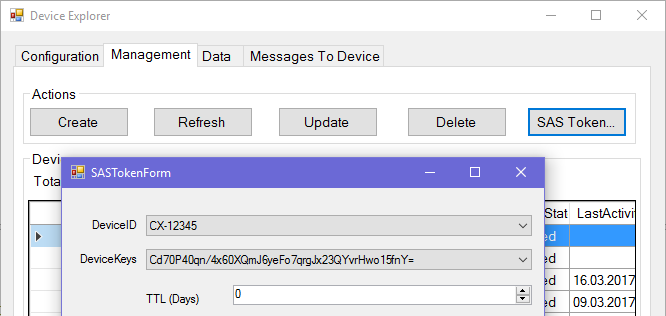IotMqttSampleAzureIotHub
Sample of MQTT communication with the Microsoft Azure IoT Hub
This sample shows communication with the Microsoft Azure IoT Hub, which is part of the Microsoft Azure cloud. The message broker can be reached via MQTT and requires authentication via an SAS token, which can be generated via the Azure IoT Hub platform, e.g. using the Azure IoT Explorer.
 | Initial setup of Azure IoT Hub For information on the initial setup of the Microsoft Azure IoT Hub and corresponding access data for devices to be connected, see the official Microsoft Azure IoT Hub documentation. We also recommend the Microsoft documentation article on using MQTT with the Azure IoT Hub. |
 | Topic structure The topic structure for sending and receiving messages is predefined by the Microsoft Azure IoT Hub. |
 | Authentication You can use either a SAS token or X509 certificates to authenticate the MQTT client. There is also the option of splitting the previously generated SAS token into individual parts (see option 3). |
 | QoS and Retain The Azure IoT Hub does not support QoS 2 and Retain messages. |
In this sample, messages are sent to the Azure IoT Hub and received from it. Since this sample is essentially based on the IotMqttSampleUsingQueue sample, only the parts that are relevant for establishing a connection to the Azure IoT Hub are explained in this section.
Parameters for establishing a connection
The following code snippet shows the parameters required for establishing a connection to the Azure IoT Hub. The parameters are essentially static parameters. These can also be specified in the declaration part during instantiation of the MQTT client.
IF bSetParameter THEN
bSetParameter := FALSE;
(* Option 1: authentication via Device SAS-Token *)
fbMqttClient.stTLS.sCA := 'c:\TwinCAT\3.1\Config\Certificates\DigiCertGlobalRootG2.cer'; // CA certificate
fbMqttClient.stTLS.sAzureSas := 'PlaceDeviceSasTokenHere'; // Device SAS Token
(* Option 2: authentication via X509 certificate *)
//fbMqttClient.stTLS.sCA := 'c:\TwinCAT\3.1\Config\Certificates\DigiCertGlobalRootG2.cer'; // CA certificate
//fbMqttClient.stTLS.sCert := 'c:\TwinCAT\3.1\Config\Certificates\MyDeviceCert.pem';
//fbMqttClient.stTLS.sKeyFile := 'c:\TwinCAT\3.1\Config\Certificates\MyDeviceCert.key';
//fbMqttClient.sHostName:= myIotHub.azure-devices.net';
//fbMqttClient.nHostPort:= 8883;
//fbMqttClient.sClientId := 'MyDevice';
//fbMqttClient.sUserName := 'myIotHub.azure-devices.net/MyDevice/?api-version=2021-04-12';
fbMqttClient.ipMessageQueue := fbMessageQueue;
(* Option 3: authentication via Device SAS-Token splitted*)
//fbMqttClient.stTLS.sCA := 'c:\TwinCAT\3.1\Config\Certificates\DigiCertGlobalRootG2.cer'; // CA certificate
//fbMqttClient.sHostName := myIotHub.azure-devices.net';
//fbMqttClient.nHostPort := 8883;
//fbMqttClient.stTLS.sVersion := 'tlsv1.2';
//fbMqttClient.sClientId := 'MyDevice';
//fbMqttClient.sUserName := 'myIotHub.azure-devices.net/MyDevice/?api-version=2021-04-12';
//fbMqttClient.sUserPassword := 'SharedAccessSignature sr=myIotHub.azure-devices.net%2Fdevices%2FMyDevice&sig=SAStokenhere&se=17495938573';
END_IFYou can use either a SAS token or X509 certificates to authenticate the MQTT client on the Azure IoT Hub. Depending on the authentication type, certain connection parameters must be set. The following table provides an overview of the parameters to be set.
| SAS token | SAS token splitted | X509 certificate |
|---|---|---|---|
stTLS.sCA | Path to the CA certificate used by the Azure IoT Hub. See below. | Path to the CA certificate used by the Azure IoT Hub. See below. | Path to the CA certificate used by the Azure IoT Hub. See below. |
stTLS.sAzureSas | SAS token, which can be generated via the Azure File Explorer. | --- | --- |
stTLS.sCert | --- | --- | Path to the client certificate. |
stTLS.sKey | --- | --- | Path to the private key. |
sHostname | Does not have to be set explicitly. The host name is derived from the SAS token. | Host name of the Azure IoT Hub instance. | Host name of the Azure IoT Hub instance. |
nHostPort | Does not have to be set explicitly. The port is automatically set to 8883 when using a SAS token. | 8883 | 8883 |
sClientId | Does not have to be set explicitly. The client ID is derived from the SAS token. | Corresponds to the device name of the created device in the Azure IoT Hub. | Corresponds to the device name of the created device in the Azure IoT Hub. |
sUserName | Does not have to be set explicitly. The user name is derived from the SAS token. | Corresponds to a fixed naming scheme, which includes both the IoT hub name and device name. For more information, please refer to the Azure IoT Hub documentation. | Corresponds to a fixed naming scheme, which includes both the IoT hub name and device name. For more information, please refer to the Azure IoT Hub documentation. |
sUserPassword | --- | Corresponds to the back part of the generated SAS token from "SharedAccessSignature" onwards (see sample). | --- |
 | CA certificate When establishing a connection to the Microsoft Azure IoT Hub via MQTT, the specification of a CA certificate is mandatory, both when using a SAS token and when using X509 certificates for client authentication. Please always consult the Microsoft documentation to find out the currently valid root CA. |

Publish
When data are published to the IoT Hub, the topic must be specified in the following form:
devices / deviceId / messages / events / readpipe
The DeviceId corresponds to the DeviceId of the registered device, as specified in the Azure IoT Explorer, for example.

Subscribe
When subscribing to data from the IoT Hub, the topic must be specified in the following form:
devices / deviceId / messages / devicebound / #
The DeviceId corresponds to the DeviceId of the registered device, as specified in the Azure IoT Explorer, for example.
Requirements
Development environment | Target platform | PLC libraries to include |
|---|---|---|
TwinCAT v3.1.4022.0 | IPC or CX (x86, x64, Arm®) | Tc3_IotBase, |